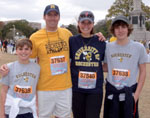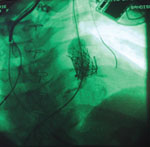|
|
|

|
New Heart Valve Offers Lifeline
|
MUSC
offers
Melody transcatheter valve procedure, quicker recovery
By Dawn Brazell
Public Relations
Laurie Fladd knew the procedure she was to have done at MUSC was
new. She just didn’t realize how new. When she found out the day before
her Jan. 26 procedure that she was to be the first patient at MUSC and
first in the state to have a transcatheter pulmonary valve inserted, it
gave her pause.
 Dr. Laurie Fladd with
her family at a Cooper River Bridge Run. Dr. Laurie Fladd with
her family at a Cooper River Bridge Run.
Briefly.
Given that the only other option was open heart surgery, Fladd, Ph.D.,
decided she was willing. Fladd, department head for physical sciences
at Trident Technical College and the active mother of two boys, had
known since age 13 that she would have to have another open heart
surgery for a valve replacement at some point.
She was thrilled to see that she could wait long enough for technology
to provide a less invasive method, she said.
 The stented valve
being expanded into postion under fluoroscopy. Watch the video at http://bit.ly/MUSC_Melody The stented valve
being expanded into postion under fluoroscopy. Watch the video at http://bit.ly/MUSC_Melody
Interventional pediatric cardiologists Rani Bandisode, M.D., and G.
Hamilton Baker, M.D., performed the procedure and were glad to see
Fladd up using her IPad the day after getting her valve. An open heart
surgery would have required a week to 10 days for recovery.
The procedure has been done on three patients so far, two of them
children, and all were able to leave the hospital the next day.
Bandisode said they are treating a larger adult population than they’ve
ever had before. “A lot of our patients with congenital heart disease
are well into their adulthood. I think our oldest patient is 76 years
old. Our patients are living longer with disease processes that they
would like to be able to manage and increase their life spans even
longer, or take away other risk factors, such as stroke. It’s pretty
amazing.”
 Dr. G. Hamilton Baker
reviews Laurie Fladd's images from her Jan. 26 Melody transcatheter
valve procedure. Dr. G. Hamilton Baker
reviews Laurie Fladd's images from her Jan. 26 Melody transcatheter
valve procedure.
MUSC is the only center in the state so far approved to have the Melody
valve procedure, one of 40 to 50 centers nationally. This is a rapidly
growing area of treatment and an exciting time to be in their field,
she said. Currently, other types of valves are being tested, with the
Melody valve the first of many types to be produced.
“Otherwise, it would impact a good portion of the population who would
have to undergo their fourth or fifth open heart surgery in their life
span. If this could keep them out of the operating room for another
open heart surgery–that would be great,” Bandisode said.
 Dr. Rani Bandisode Dr. Rani Bandisode
Phil Saul, M.D., director of the division of pediatric cardiology
and Fladd’s primary cardiologist, agrees it’s an exciting option to
offer patients.
The Melody transcatheter valve procedure is for patients with either
damaged or absent valves in the pulmonary position, which handles blood
flow from the right ventricle to the lungs. The valve is sewn into a
stent with the whole device being crimped down to fit over a balloon
catheter. It’s placed through a vein and is advanced through a special
delivery sheath. The balloon is expanded, which expands the stent, the
vein and the valve into place in the correct position. The stent is a
stainless steel tube with many little slits that grab onto tissue when
the stent is expanded, he said.
 Dr. Phil Saul Dr. Phil Saul
“In the past these kinds of patients have often gone many years with a
leaky pulmonary valve—that’s the main valve that goes to the lungs.
What would happen is that over time, the right-sided pumping chamber of
the heart would dilate. Eventually, it would cause patients to have
decreased exercise tolerance, and we would get to the point we’d have
to replace that valve surgically. That was really the only option.”
The Melody catheter-delivered valve allows doctors to intervene sooner
instead of waiting until patients get to the point of having poor
exercise tolerance, decreased right ventricular function and an
increased risk for the right ventricle to be unable to recover, he
said.
“This represents another step of the pediatric heart team to take
procedures that used to be done exclusively in the operating room and
perform them in minimally-invasive catherization procedures.”
The hope is to put in devices that will last long enough that patients
can have a series of catherizations that will get them through old age.
Generally, these bioprosthetic valves last seven to 15 years. “We’re
thinking ‘let’s put this in now and see how the technology will catch
up.’ It doesn’t mean that no one will ever need surgery, but we can
reduce the amount.”
Baker said a difference with the Melody valve is that the device was
built to be appropriate for children as well as adults.
“It was built for our specific population. It makes parents
extraordinarily happy when their kids get to come the next day instead
of a few days to a week with a surgical scar that has to heal over the
course of a month or two. They’re able to get back to their regular
activities in a short period of time.”
Saul said it worked perfectly for Fladd in two ways.
“By using the stent expansion, we were able to expand out the narrowed
area so that she no longer had any stenosis and put the valve into
place so that she no longer had any regurgitation. It worked like a
perfect, normal valve.”
Fladd, who’s already training for the Cooper River Bridge run/walk with
her family, said an open heart surgery would have been very disruptive
to their family schedule. “We’ve always joked that the longer I could
wait, the likelier they’d come up with something better. I understand
it’s temporary, but even if I get half of the time I did with the
other, I’d be thrilled.”
As a baby, she was born blue and had to have a valve replacement. She’s
had open-heart surgery three times. She said this procedure was much
easier and only required an overnight stay. “Everyone from the time I
checked in from the time I went home was great. They’re fantastic.”
She likes it that the procedure served as a preventative measure before
she started developing more serious symptoms. She’s eager to get back
to her fitness activities that range from kayak to yoga.
“We do the bridge run together as a family. I want to make sure that
I’m able to keep up with my family. That means the world to me. I don’t
want be in a wheelchair or not be able to see things because it’s too
tiring for me to get there. That’s really important to me.”
Friday, March 4,
2011
|
|
|







